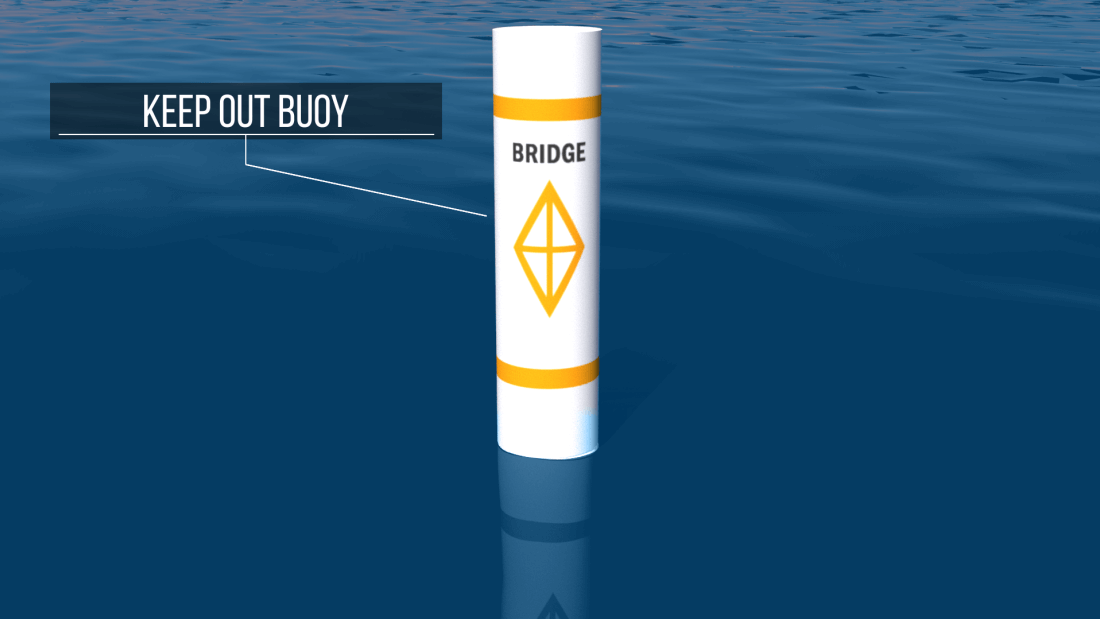Safer boating through tridges
Traveling the inland waterways can be a pleasant experience but can also bring some special challenges especially for larger boats and sailboats. Dealing with drawbridges takes some knowledge of how the system works and knowing what you are looking for, especially at night.
Nautical charts only tell you that there is a bridge and what the horizontal clearance (width) and vertical clearance (height) are. The vertical clearance is the one you are probably going to be most concerned with, i.e. will you fit under the bridge or will you have to open it?

You should consult your chart for the note on heights; most will show minimum vertical clearance at mean high water. That means if you are at the bridge at any time other than high tide, you should have more clearance than shown. (You'll be able to tell exactly when you get there). You should, prior to planning a trip, consult the Coast Pilot or Cruising Guides for the area you will be traveling and make notes in your trip log concerning bridges including name of bridge, hours of operation, recommended method of contact, etc.
As you approach a bridge there are several things that you should look for. You should check the right side of the bridge opening for the "clearance board". This will give you the minimum clearance, in feet, from the water level to the bridge structure. This will determine whether you can clear the bridge or will need to have it open. Speaking of opening a bridge, you should know the vertical height of your boat prior to getting to the bridge. Do not cause unnecessary openings, it is illegal!
According to U.S. Coast Guard regulations, you may be subject to both criminal and civil penalties for causing an unnecessary bridge opening because of "any nonstructural vessel appurtenance which is not essential to navigation or which is easily lowered". In other words if the only thing making you open the bridge is your VHF antenna or outriggers, take them down. These same regulations also provide penalties for any bridge tender who “unnecessarily delay the opening of a drawbridge after the required signal has been given".
Even if you can navigate under the bridge with plenty of clearance, always slow down and do so at idle speed. You cannot see if another boater is on the other side, out of view, until the boat suddenly darts out into the bridge channel.
Other things to look for as you approach the bridge is a blue sign with what looks like a telephone receiver with a lightning bolt through it. This will give you the radio frequencies that the bridge monitors (usually 16 and 13 or 9). It is customary, at least in most areas, to contact the bridge tender by VHF radio to request an opening, however, there is a sound signal that can be used. The sound signal to contact the bridge is one prolonged blast followed within 3 seconds with one short blast. The bridge tender will acknowledge an OK with the same signal. If there is a problem in opening at that time the bridge tender will answer with a "NO" by sounding five short blasts. You acknowledge your understanding of the "NO" by responding with five short blasts.
Another piece of information on the bridge will be its name. If you didn't do your homework when you planned the trip you will need to know that name to call the bridge. It is not specific enough to just call out "bridge, bridge, bridge". Especially in an area that may have several, uniquely named, drawbridges within VHF radio range. Bridge tenders can sometimes be a little cranky. Perhaps it comes from sitting for long periods of time in a space not much bigger than an outhouse. Even if you know the bridge opens on demand, try not to demand. Call the bridge on the radio and ask when the next scheduled opening is. If it is on demand, the bridge tender will usually say "come on up skipper, I'll open when you get here."
On the bridge you will also find a white sign that shows the hours of operation and special operational procedures. You should note that some bridges open on demand year-round and some only open on demand during certain parts of the year. In areas where the boating population grows significantly in the wintertime, many bridges open only at certain times (perhaps every half-hour) during the “season.”
You may also find regulatory signs on bridges with information on speed limits or other warnings. In many cases speed limits may change at a bridge so be careful to heed these regulatory signs. The bridge structure makes a great place to set up a marine speed trap.
When approaching a bridge at night you will see three red lights in a triangular pattern. The two lower lights indicate the bridge opening just above water level and the center light hangs from the center of the bridge span. If you line up with the center light and keep the relative relationship of the lower lights equidistant on either side you can be assured that you are in the center.
While waiting for the bridge to open be aware of your position and make sure that current is not carrying you into the bridge.
Once the bridge is open proceed through with caution. Many times, if there is wind or current, you may find your steering affected. Keep a close eye out and try to anticipate any corrections that need to be made. Be sure to look out for other boats that may be waiting on the other side who also want to come through during the opening. Once clear of the bridge you may resume the permitted speed for the area and it is a good idea to thank the bridge tender.